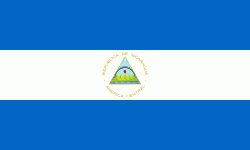Murra (Municipio de Murra)
Murra is a municipality in the Nueva Segovia Department of Nicaragua.
Murra is a small municipal head in eastern Nueva Segovia department. The tiny pueblo has a population of approximately 1,000 inhabitants and is made up of four barrios (neighborhoods) squeezed into a narrow valley, high up in the mountains. The people in Murra make their living primarily from farming corn and beans, and raising coffee. Although its population is small, Murra is the center for many rural communities: about 17,000 people in total live throughout the entire municipal region. So, many people also make a living as shop owners and vendors. Situated in a high mountainous region, Murra's climate is significantly cooler than much of Nicaragua. Murra has electricity and a running water system. There are several pulperias (shops) in Murra, three comedores (restaurants) and two hospedajes (very small hotels). The community has one Catholic parrish church, and two Protestant temples.
* Photos of Murra — @ Adventures of a GoodMan
Murra is a small municipal head in eastern Nueva Segovia department. The tiny pueblo has a population of approximately 1,000 inhabitants and is made up of four barrios (neighborhoods) squeezed into a narrow valley, high up in the mountains. The people in Murra make their living primarily from farming corn and beans, and raising coffee. Although its population is small, Murra is the center for many rural communities: about 17,000 people in total live throughout the entire municipal region. So, many people also make a living as shop owners and vendors. Situated in a high mountainous region, Murra's climate is significantly cooler than much of Nicaragua. Murra has electricity and a running water system. There are several pulperias (shops) in Murra, three comedores (restaurants) and two hospedajes (very small hotels). The community has one Catholic parrish church, and two Protestant temples.
* Photos of Murra — @ Adventures of a GoodMan
Map - Murra (Municipio de Murra)
Map
Country - Nicaragua
 |
 |
| Flag of Nicaragua | |
Originally inhabited by various indigenous cultures since ancient times, the region was conquered by the Spanish Empire in the 16th century. Nicaragua gained independence from Spain in 1821. The Mosquito Coast followed a different historical path, being colonized by the English in the 17th century and later coming under British rule. It became an autonomous territory of Nicaragua in 1860 and its northernmost part was transferred to Honduras in 1960. Since its independence, Nicaragua has undergone periods of political unrest, dictatorship, occupation and fiscal crisis, including the Nicaraguan Revolution of the 1960s and 1970s and the Contra War of the 1980s.
Currency / Language
| ISO | Currency | Symbol | Significant figures |
|---|---|---|---|
| NIO | Nicaraguan córdoba | C$ | 2 |
| ISO | Language |
|---|---|
| EN | English language |
| ES | Spanish language |















